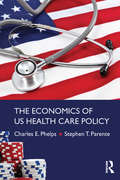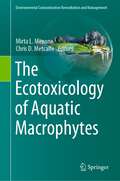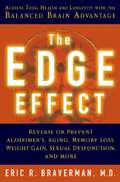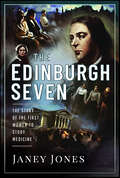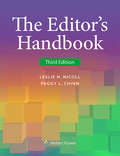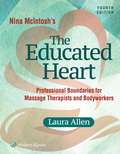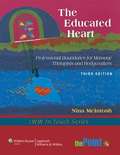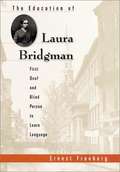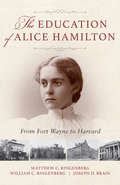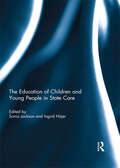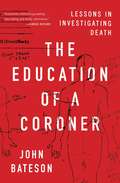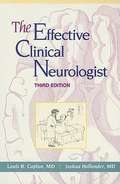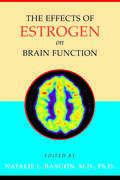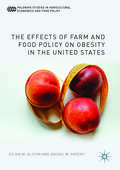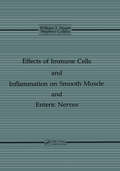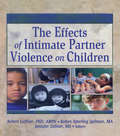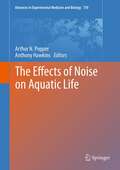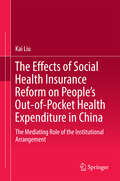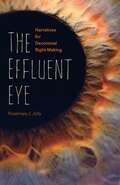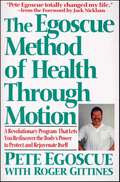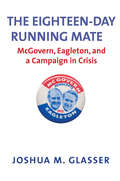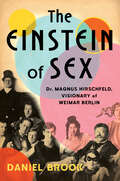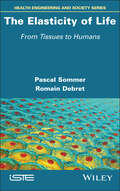- Table View
- List View
The Economics of US Health Care Policy
by Charles E. Phelps Stephen T. ParenteIn this book, Phelps and Parente explore the US health care system and set out the case for its reform. They trace the foundations of today’s system, and show how distortions in the incentives facing participants in the health care market could be corrected in order to achieve lower costs, a higher quality of care, a higher level of patient safety, and a more efficient allocation of health care resources. Phelps and Parente propose novel yet economically robust changes to US tax law affecting health insurance coverage and related issues. They also discuss a series of specific improvements to Medicare and Medicaid, and assess potential innovations that affect all of health care, including chronic disease management, fraud and abuse detection, information technology, and other key issues. The Economics of US Health Care Policy will be illuminating reading for anyone with an interest in health policy, and will be a valuable supplementary text for courses in health economics and health policy, including for students without advanced training in economics.
The Ecotoxicology of Aquatic Macrophytes (Environmental Contamination Remediation and Management)
by Chris D. Metcalfe Mirta L. MenoneThis book focuses on the topic of ecotoxicology of aquatic macrophytes and is wide ranging, including the use of macrophytes for remediation of contaminated sites. Many human activities are threats to the equilibrium of natural ecosystems. Pollution from point and non-point sources can be assessed using a variety of techniques, such as biomonitoring, biomarkers and biosensors. In aquatic ecosystems, biomonitoring of pollutants is mostly conducted by analysis of the tissues of invertebrates and fishes, and biomarker studies are also more widely applied to animals rather than in plants. Aquatic macrophytes occupy a key niche in aquatic ecosystems and provide a range of ecosystem services. In addition to their role in primary production, vegetation plays a key role in the cycling and retention of nutrients and generally acts as a sink for pollutants. Therefore, because of their importance to aquatic ecosystems, more attention should be paid to understanding the fate of pollutants and to developing methods to evaluate the health status of macrophytic plants in freshwater, marine and estuarine environments.
The Edge Effect: Achieve Total Health and Longevity with the Balanced Brain Advantage
by Eric R. BravermanA proven program to reverse and prevent aging that will be a must-have for all “baby boomers,” by a leading figure in the medical field and a frequent guest on national TV.This could be as close to a fountain of youth as mankind will ever come, the truly scientific answer to how to reverse or prevent the debilitating effects of aging, including memory loss, weight gain, sexual dysfunction, and Alzheimer’s.Dr. Eric Braverman, a leading figure in the practice of brain-body health care, reveals the dramatic impact that proper brain nourishment can have on the quality of our lives. His key to longevity and well-being is balancing the brain’s four important neurotransmitters. A simple test determines which of the four is dominant in you, and what you can do to maintain the right balance, by modifying your diet with both foods and natural supplements. Proven effective for thousands of patients in Dr. Braverman’s practice, this groundbreaking approach will help anyone make the most of his or her life, free of the major illnesses (such as cancer and heart disease) and minor ailments as well.
The Edinburgh Seven: The Story of the First Women to Study Medicine
by Janey JonesWomen have healed since the beginning of time, but accessing a formal degree in medicine was impossible for them in Britain until the late 19th century. In 1869, a group of women began arriving in Edinburgh to study at the medical faculty, led by the indomitable Sophia Jex Blake. They would eventually be known around the world as The Edinburgh Seven. They were delighted to become students of medicine and as Sophia said, they simply wanted 'a fair field and no favour'. But some of the traditional professors at the university did not approve of women becoming practicing doctors. The medical women would soon discover that they were welcome as hobbyists but not as competitors with male students. There were legal wrangles, court cases, personal attacks and even a full blown riot - all because some male medics wanted rid of the women. And the women did leave Edinburgh - without degrees. But they finished their studies in mainland Europe and came back as fully fledged doctors. In 2019, the University of Edinburgh awarded the Seven their degrees posthumously via current day medical students. At last, the right thing was done, but the struggles of the original Seven should never be forgotten. This is their story.
The Editor's Handbook
by Leslie H. Nicoll Peggy L. ChinnThe completely updated 3rd edition of The Editor’s Handbook is an invaluable resource to all those involved in various aspects of scholarly writing in nursing. Both novice and experienced editors will no doubt find the information quite useful, as they did the first two editions. Although the main focus of the handbook is on the editors of nursing journals, all types of nurse writers will appreciate the extensive details and helpful tips. Nurses who are in the process of preparing manuscripts for publication can use the handbook to enhance their success at journal acceptance by getting a unique view of the editor’s role and perspective.
The Educated Heart: Professional Boundaries For Massage Therapists And Bodyworkers
by Laura AllenNow including an all-new chapter on professional boundaries and the Internet, this fully updated 4th Edition of Nina McIntosh’s The Educated Heart, by Laura Allen provides a conversational style, easy-to-understand explanations of complex psychological dynamics, and practical suggestions for handling everyday boundary situations. <p><p> Packed with real-world examples, and compelling online videos, this practical, compassionate book explores common situations bodyworkers and massage therapists encounter on the job and provides compassionate support and up-to-date information to help readers establish the solid professional boundaries they need for career success and personal well-being.
The Educated Heart: Professional Boundaries for Massage Therapists and Bodyworker (3rd Edition)
by Nina McintoshThe Educated Heart demystifies the important issues of establishing professional relationships in the manual therapies. The author uses humor, compassion, and humanity to present this complicated content in terms that are highly readable and engaging. The book includes real-life examples and practical solutions to dilemmas and sensitive situations that all bodyworkers face in their everyday practice.
The Education Of Laura Bridgman: First Deaf And Blind Person To Learn Language
by Ernest FreebergIn the mid-nineteenth century, Laura Bridgman, a young child from New Hampshire, became one of the most famous women in the world. Philosophers, theologians, and educators hailed her as a miracle, and a vast public followed the intimate details of her life with rapt attention. This girl, all but forgotten today, was the first deaf and blind person ever to learn language. Laura's dark and silent life was transformed when she became the star pupil of the educational crusader Dr. Samuel Gridley Howe. Against the backdrop of an antebellum Boston seething with debates about human nature, programs of moral and educational reform, and battles between conservative and liberal Christians, Freeberg tells this extraordinary tale of mentor and student, scientist and experiment. Under Howe's constant tutelage, Laura voraciously absorbed the world around her, learning to communicate through finger language, as well as to write with confidence. Her remarkable breakthroughs vindicated Howe's faith in the power of education to overcome the most terrible of disabilities. In Howe's hands, Laura's education became an experiment that he hoped would prove his own controversial ideas about the body, mind, and soul. Poignant and hopeful, The Education of Laura Bridgman is both a success story of how a sightless and soundless girl gained contact with an ever-widening world, and also a cautionary tale about the way moral crusades and scientific progress can compromise each other. Anticipating the life of Helen Keller a half-century later, Laura's is a pioneering story of the journey from isolation to accomplishment, as well as a window onto what it means to be human under the most trying conditions.
The Education of Alice Hamilton: From Fort Wayne to Harvard
by William C. Ringenberg Matthew C. Ringenberg Joseph D. BrainA biography of Harvard’s first female faculty member—a pioneer in public health and worker safety.Born and raised in Fort Wayne, Indiana, Alice Hamilton graduated from medical school in 1893, and after completing internships at hospitals in Minneapolis and Boston, she rejected private practice and began dedicating herself to public health. Focusing on the investigation of the health and safety measures—or rather lack thereof—in the nation’s factories and mines during the second decade of the twentieth century, her discoveries led to factory and mine level-initiated reforms, and to city, state, and federal reform legislation. It also led to a greater recognition in the nation’s universities for formal academic programs in industrial and public health. In 1919, Harvard officials considered Hamilton the best-qualified person in the country to lead their effort in this area. The Education of Alice Hamilton is an inspiring story of a woman who lived a remarkable life at a time when women were not always welcome in medical circles—serving as personal physician to Jane Addams, founder of Hull House; traveling to the Soviet Union and Nazi Germany; researching the effects of mercury, carbon monoxide, benzene, and other substances on workers. She was sometimes ignored—such as when she warned of the dangers of lead in gasoline decades before it was eventually banned—but she persisted, and thanks in part to her groundbreaking work, Americans now enjoy the protection of OSHA, the Occupational Safety and Health Act.
The Education of Children and Young People in State Care
by Sonia Jackson and Ingrid HöjerYoung people who leave care with few or no educational qualifications are at very high risk of social exclusion in adulthood. Yet in the past their education has attracted little attention from researchers or professionals. Studies by the editors and contributors to this volume show that the educational standards attained by young people in care fall progressively behind those of their peers living with their own families. This research-based book looks at the educational experiences of children and youths in nine different European countries and Canada. It identifies the obstacles that prevent them from realising their aspirations and discusses ways of improving their opportunities. How can countries with different traditions, welfare regimes and administrative systems learn from each other? What needs to be done at national, local and individual levels to give children in care equal chances with those living with their families? At present a child in public care is five times less likely to go to university than others. How can teachers, social workers and carers better support their educational attainment, and enable more of them to succeed and progress to tertiary education? This book was originally published as a special issue of the European Journal of Social Work.
The Education of a Coroner: Lessons in Investigating Death
by John BatesonIn the vein of Dr. Judy Melinek’s Working Stiff, an account of the hair-raising and heartbreaking cases handled by the coroner of Marin County, California throughout his four decades on the job—from high-profile deaths to serial killers, to Golden Gate Bridge suicides.Marin County, California is a study in contradictions. Its natural beauty attracts thousands of visitors every year, yet the county also is home to San Quentin Prison, one of the oldest and largest penitentiaries in the country. Marin ranks in the top one percent of counties nationwide in terms of affluence and overall health, yet it is far above the norm in drug overdoses and alcoholism, and comprises a large percentage of suicides from the Golden Gate Bridge. Ken Holmes worked in the Marin County Coroner’s Office for thirty-six years, starting as a death investigator and ending as the three-term, elected coroner. As he grew into the job—which is different from what is depicted on television—Holmes learned a variety of skills, from finding hidden clues at death scenes, interviewing witnesses effectively, managing bystanders and reporters, preparing testimony for court to notifying families of a death with sensitivity and compassion. He also learned about different kinds of firearms, all types of drugs—prescription and illegal—and about certain unexpected and potentially fatal phenomena such as autoeroticism. Complete with poignant anecdotes, The Education of a Coroner provides a firsthand and fascinating glimpse into the daily life of a public servant whose work is dark and mysterious yet necessary for society to function.
The Effective Clinical Neurologist
by Louis R. Caplan Joshua HollanderThe Effective Clinical Neurologist presents the most systematic guide available for the doctor or medical student learning the art of the neurological examination and treatment. The patient-centered method is presented in logical steps, walking the reader through the process in a clear and detailed, yet personal style. The authors begin by placing neurological medicine in its current cultural and economic environment and progress to presenting the specific process of interacting with the patient. <P><P> This book is the only guide to the art of achieving optimal doctor-patient interaction and communication, which are essential to the practicing neurologist. The third edition of this classic reference is fully updated to include the impact of electronic communication and to incorporate the many technological advances that can be applied to the neurological evaluation. Other changes in the environment in which the clinician practices include the changes in procedure brought about by managed care. <P><P> This edition is organized into four parts, beginning with a section on the clinician-neurologist and the scope, methods, and uniqueness of this area of medicine. Part II focuses on the patient encounter - the taking of a history, systemic and neurological examination, interpretation of tests, giving the patient information, and conducting the "dismissal interview". <P><P> Case examples illustrate the methods discussed. Part III presents the various types of encounters that occur, including those that involve inpatient care, outpatient care, consultations, and the inclusion of medical students and other trainees. Medico-legal aspects of neurological care are also presented. Part IV concludes with a summing up of the approach to patient care that is presented in the book and offers 10 Commandments of Doctoring.
The Effects of Estrogen on Brain Function
by Natalie L RasgonThis timely volume reviews current data on the effects of estrogen on the central nervous system, highlighting clinical aspects of this topic. Experts from the fields of psychiatry, pharmacology, neurology, and geriatrics collaborate to clarify the known risks and benefits of hormone therapy and explore questions that remain to be elucidated.Among the topics discussed:" Preclinical data on estrogen's effects on cognitive performance" The short-lived effects of hormone replacement therapy on cognitive function" Structural and functional brain imaging data regardingestrogen's effects on the central nervous system " Preclinical efforts to develop effective NeuroSERMs for the brain " The effects of estrogen on moodCiting the ongoing confusion over the risks and benefits of estrogen therapy, the contributors emphasize the need for additional research on medication, doses, preparations, methods of administration, alternative therapies, and supplements. This volume educates researchers, clinicians, and students on the current knowledge—including the effects of estrogen on mood, cognition, and brain metabolism—and provides guidelines for clinical practice and future research.Contributors: Roberta Diaz Brinton, Ph.D., University of Southern California; Cheri L. Geist, B.A., David Geffen School of Medicine, University of California at Los Angeles; Robert B. Gibbs, Ph.D., University of Pittsburgh School of Pharmacy; Eva Hogervorst, Ph.D., University of Loughborough and University of Oxford; Pauline M. Maki, Ph.D., Neuropsychiatric Institute, University of Illinois–Chicago; Peter J. Schmidt, M.D., National Institute of Mental Health; Daniel H. S. Silverman, M.D., Ph.D., David Geffen School of Medicine, University of California at Los Angeles; Katherine E. Williams, M.D., Stanford University School of Medicine; Kristine Yaffe, M.D., University of California, San Francisco, and San Francisco VA Medical Center; Laurel N. Zappert, B.A., Stanford University School of Medicine; Liqin Zhao, Ph.D., University of Southern California
The Effects of Farm and Food Policy on Obesity in the United States
by Julian M. Alston Abigail M. OkrentThis book uses an economic framework to examine the consequences of U. S. farm and food policies for obesity, its social costs, and the implications for government policy. Drawing on evidence from economics, public health, nutrition, and medicine, the authors evaluate past and potential future roles of policies such as farm subsidies, public agricultural R&D, food assistance programs, taxes on particular foods (such as sodas) or nutrients (such as fat), food labeling laws, and advertising controls. The findings are mostly negative--it is generally not economic to use farm and food policies as obesity policy--but some food policies that combine incentives and information have potential to make a worthwhile impact. This book is accessible to advanced undergraduate and graduate students across the sciences and social sciences, as well as to decision-makers in the public, private, and not-for-profit sectors.
The Effects of Immune Cells and Inflammation On Smooth Muscle and Enteric Nerves
by Jr. Snape Stephen M. CollinsThis book provides the first comprehensive review of research that addresses the immunomodulation of gastrointestinal motility. Results from this new field of research are important for understanding motility disturbances and symptom-generation in a variety of clinical gastroenterological problems, including ulcerative colitis, Crohn's disease, enteric infections, and food allergies. The book provides overviews on current perspectives regarding the nature of inflammatory processes, inflammatory mediators, and other immune factors. It also describes a variety of experimental approaches that have been used to study the interactions between immune cells and smooth muscle or enteric nerves. The approaches include in vivo, as well as in vitro studies. Researchers involved in the general field of immunophysiology, as well as the more specific fields of gastrointestinal motility and inflammatory bowel diseases will find this book to be invaluable in their research.
The Effects of Intimate Partner Violence on Children
by Robert A. Geffner Robyn Spurling Igelman Jennifer ZellnerLearn how to help children cope with domestic violence! The Effects of Intimate Partner Violence on Children examines the short- and long-term developmental issues facing children exposed to violence in their own homes. The book addresses the growing concern for children at risk of suffering psychological, behavioral, social, and educational problems, and for the effects childhood maltreatment may have on their adult lives. An interdisciplinary panel of researchers, academicians, attorneys, clinicians, and practitioners discuss treatment programs, theoretical perspectives, research and methodological issues, assessment and intervention, and forensic issues, including child custody. The Effects of Intimate Partner Violence on Children addresses the emotional and behavioral disturbances children can suffer after being exposed to violence between their parents. It examines methodological and theoretical challenges, pilot programs for treatment, intervention models, therapeutic curricula, and family law. Practitioners and academics review dozens of studies, representative samples, probability samples, and research findings relating to children's internalizing and externalizing behaviors, adjustment difficulties, coping strategies. The book also examines: the association between emotional regulation and emotionality and marital and parent-child conflict in terms of children's adjustment and physical health how the experience of mothers in low-income families suffering severe physical abuse relates to children's behavior problems. how father-to-mother aggression reduces children's affinity with their parents problems of service delivery for battered mothers Canadian legislation involving wife abuse and child custody the well-being of families accessing treatment group interventions implemented in family agency and school settings how to develop interagency protocols and much more! The Effects of Intimate Partner Violence on Children is an essential resource for professionals, advocates, and practitioners who work with abused children and maltreating families.
The Effects of Music: A series of Essays (International Library Of Psychology Ser.)
by Max SchoenThis is Volume XVIII of twenty-one of collection of works on Cognitive Psychology. Initially published in 1927 it offers a collection of essays on the effects of music on the listerner.The book is at once a response and a challenge. It is a response to the inquiry which any thoughtful listener makes, “ What is this music doing to me ? ” A t the same time it is a challenge to science to explain more adequately than has as yet been done the nature and the mysteries of musical effects.
The Effects of Noise on Aquatic Life
by Arthur N. Popper Anthony HawkinsThe Second International Conference on the Effects of Noise on Aquatic Life will take place in Ireland August 15-20, 2010. The main emphasis of the conference will be on defining the current state of knowledge. However, we will also assess progress in the three years since the First conference. The Second conference will place strong emphasis on recent research results, the sharing of ideas, discussion of experimental approaches, and analysis of regulatory issues.
The Effects of Noise on Aquatic Life: Principles and Practical Considerations
by Arthur N. Popper Anthony D. Hawkins Joseph A. Sisneros Frank ThomsenIn this landmark new work, the major authorities in the field from around the world present a wealth of research data, coverage of regulatory issues, and thinking about the effects of man-made noise on marine mammals, turtles, amphibians, fishes, and invertebrates. The various themes of the book were chosen to cover the wide range of basic and cutting edge information on this topic. They include the hearing abilities of aquatic animals; communication by means of underwater sound; the description of aquatic soundscapes; different sound sources and their characteristics; the effects of sound on behavior; and assessing, mitigating, and monitoring the effects of aquatic noise. Emphasis is on the cross-fertilization of ideas and findings across species and noise sources. With over 140 contributions from leading researchers, the sources of underwater sound and their effects are discussed in detail.
The Effects of Social Health Insurance Reform on People’s Out-of-Pocket Health Expenditure in China
by Kai LiuThis study examines and explains the relationship between social health insurance (SHI) participation and out-of-pocket expenditures (OOP) as well as the mediating role the institutional arrangement of SHI plays in this relationship in China. Embracing a new institutionalist approach, it develops two analytical perspectives: determination, which identifies the mechanisms of social health insurance, and strategic interaction, which explores the interaction among social health insurance agencies, healthcare providers, patients, and institutions. It reveals the poor performance of social health insurance in decreasing out-of-pocket health expenditures caused by a trade-off between the reimbursement, behavior management, and purchasing mechanisms of social health insurance programs. Further, it finds that the inequitable allocation of healthcare resources and patients concerns regarding the benefits offset the strategies used by social health insurance agencies to manage care-seeking behavior. It also discovers that the complex interactions between insurance agencies, doctors, patients and a larger disenabling institutional surrounding restricts the purchasing efficiency of social health insurance. This book is characterized by its unique synthesis of the role of the institutional arrangement of social health insurance in China, the interaction between the stakeholders in health sectors, and of the relationship between healthcare institutions, actors, and policy outcomes. Providing a comprehensive overview, it enables scholars and graduate students to understand the ongoing process of social health insurance reform as well as the dynamics of health cost inflation in China. It also benefits policymakers by recommending a single-payer model based on an evidence-based investigation. "
The Effluent Eye: Narratives for Decolonial Right-Making
by Rosemary J. JollyWhy human rights don&’t work In The Effluent Eye, Rosemary J. Jolly argues for the decolonization of human rights, attributing their failure not simply to state and institutional malfeasance but to the very concept of human rights as anthropocentric—and, therefore, fatally shortsighted. In an engaging mix of literary and cultural criticism, Indigenous and Black critique, and substantive forays into the medical humanities, Jolly proposes right-making in the demise of human rights. Using what she calls an &“effluent eye,&” Jolly draws on &“Fifth Wave&” structural public health to confront the concept of human rights—one of the most powerful and widely entrenched liberal ideas. She builds on Indigenous sovereignty work from authors such as Robin Wall Kimmerer, Leanne Betasamosake Simpson, and Mark Rifkin as well as the littoral development in Black studies from Christine Sharpe, Saidiya Hartman, and Tiffany Lethabo King to engage decolonial thinking on a range of urgent topics such as pandemic history and grief; gender-based violence and sexual assault; and the connections between colonial capitalism and substance abuse, the Anthropocene, and climate change. Combining witnessed experience with an array of decolonial texts, Jolly argues for an effluent form of reading that begins with the understanding that the granting of &“rights&” to individuals is meaningless in a world compromised by pollution, poverty, and successive pandemics. Retail e-book files for this title are screen-reader friendly.
The Egoscue Method of Health Through Motion: A Revolutionary Program That Lets You Rediscover the Body's Power to Protect and Rejuvenate Itself
by Pete Egoscue Roger GittinesNo one is immune. For people from champion athletes to desk-bound white-collar professionals, many simple acts of life--a relaxing evening stroll through the neighborhood, an exhilarating run along a sandy beach, just bending down to tie a loose shoelace-are often acts of torture. The walking wounded suffer from torn rotator cuffs, tennis elbow, jogger's knees, bad backs, stiff necks, sore feet, and swollen ankles. It could, without exaggeration, be called a modem epidemic. In this brilliant book, renowned anatomical functionalist Pete Egoscue identifies the epidemic's causes and effects. By recognizing that the human body is dependent on adequate motion to maintain its full range of physical functions, he has revolutionized both the treatment of musculoskeletal pain and the techniques for training athletes to achieve peak performance levels. Brimming with common sense and practical advice, the heart of this important book consists of twenty-two easy-to-do, highly effective exercises that stretch, strengthen, and relax the body, allowing a return to proper alignment.
The Eighteen-Day Running Mate
by Joshua M. GlasserNo skeletons were rattling in his closet, Thomas Eagleton assured George McGovern’s political director. But only eighteen days later—after a series of damaging public revelations and feverish behind-the-scenes maneuverings—McGovern rescinded his endorsement of his Democratic vice-presidential running mate, and Eagleton withdrew from the ticket. This fascinating book is the first to uncover the full story behind Eagleton's rise and precipitous fall as a national candidate. Within days of Eagleton's nomination, a pair of anonymous phone calls brought to light his history of hospitalizations for “nervous exhaustion and depression” and past treatment with electroshock therapy. The revelation rattled the campaign and placed McGovern's organization under intense public and media scrutiny. Joshua M. Glasser investigates a campaign in disarray and explores the perspectives of the campaign’s key players, how decisions were made and who made them, how cultural attitudes toward mental illness informed the crisis, and how Eagleton's and McGovern's personal ambitions shaped the course of events. Drawing on personal interviews with McGovern, campaign manager Gary Hart, political director Frank Mankiewicz, and dozens of other participants inside and outside the McGovern and Eagleton camps—as well as extensive unpublished campaign records—Glasser captures the political and human drama of Eagleton's brief candidacy. Glasser also offers sharp insights into the America of 1972—mired in war and anxious about the economy, a time with striking similarities to our own.
The Einstein of Sex: Dr. Magnus Hirschfeld, Visionary of Weimar Berlin
by Daniel BrookAn illuminating portrait of a lost thinker, German-Jewish sexologist and activist Magnus Hirschfeld. More than a century ago, Dr. Magnus Hirschfeld, dubbed the “Einstein of Sex,” grew famous (and infamous) for his liberating theory of sexual relativity. Today, he’s been largely forgotten. Journalist Daniel Brook retraces Hirschfeld’s rollicking life and reinvigorates his legacy, recovering one of the great visionaries of the twentieth century. In an era when gay sex was a crime and gender roles rigid, Hirschfeld taught that each of us is their own unique mixture of masculinity and femininity. Through his public advocacy for gay rights and his private counseling of patients toward self-acceptance, he became the intellectual impresario of Berlin’s cabaret scene and helped turn his hometown into the world’s queer capital. But he also enraged the Nazis, who ransacked his Institute for Sexual Science and burned his books Driven from his homeland, Hirschfeld traveled to America, Asia, and the Middle East to research sexuality on a global scale. Through his harrowing lived experience of antisemitic persecution and a pivotal late-in-life interracial romance, he came to see that race, like gender, was a human invention. Hirschfeld spent his final years in exile trying to warn the world of the genocidal dangers of racism. Rich in passion and intellect, The Einstein of Sex at last brings together this unsung icon’s work on sexuality, gender, and race and recovers the visionary who first saw beyond the binaries. A century after his groundbreaking work—as the fights for personal freedom and societal acceptance rage on—Hirschfeld’s gift for thinking beyond the confines of his world has much to teach us
The Elasticity of Life: From Tissues to Humans
by Pascal Sommer Romain DebretElasticity is absolutely necessary for living a normal life. This fact is cruelly revealed when respiratory, cardiac, digestive, sensory, motor, reproductive or aesthetic problems appear following the inexorable decline of our elastic capital. The protection and maintenance of this capital is one of life’s priorities since this declination begins at the age of twenty and accelerates in times of crises and pandemics. However, there are no therapies yet designed to remedy it. The first part of the book explains the consequences surrounding a lack of elasticity in the skin, the most visible decline, and then other defects in elasticity throughout our bodies, exploring places rarely mentioned. The second part describes the research fighting against elasticity anomalies and examines useful behaviors to protect our elastic capital (e.g. our diets and physical and cognitive activities). This last point is at the heart of current social debates on nutritional, behavioral, environmental and even ethical levels.
